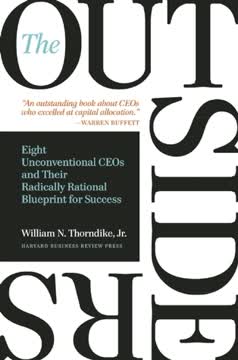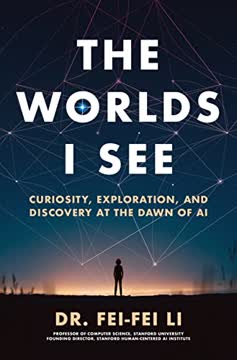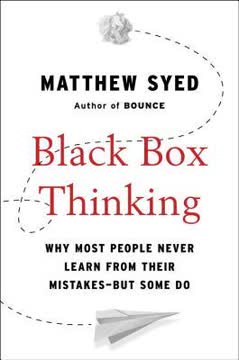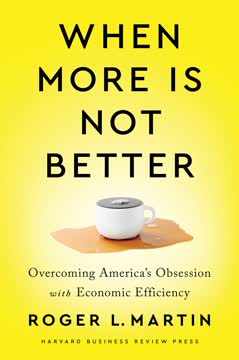Key Takeaways
1. Integrative thinking: The key to superior business solutions
The test of a first-rate intelligence is the ability to hold two opposing ideas in mind at the same time and still retain the ability to function.
Integrative thinking defined. Integrative thinking is the ability to constructively face the tension of opposing ideas and generate a creative resolution and a new idea containing elements of the opposing ideas but superior to each. This approach allows leaders to create breakthrough solutions by considering multiple perspectives and refusing to accept trade-offs.
Real-world examples. Several business leaders have demonstrated integrative thinking:
- Isadore Sharp created Four Seasons Hotels by combining the intimacy of small motels with the amenities of large hotels
- A.G. Lafley revitalized Procter & Gamble by simultaneously cutting costs and investing in innovation
- Bob Young of Red Hat found a way to profit from free software by providing value-added services
2. Embrace complexity and resist simplification
Everything should be as simple as possible, but no simpler.
The pitfalls of oversimplification. Many organizations and individuals tend to simplify complex problems, often leading to suboptimal solutions. This tendency stems from our natural inclination to make sense of a complex world and our education systems that reward finding single "right" answers.
Benefits of embracing complexity:
- Allows for consideration of more salient features
- Enables understanding of multidirectional and nonlinear causal relationships
- Facilitates holistic problem-solving approaches
- Increases the likelihood of finding creative resolutions
Integrative thinkers like Martha Graham in dance and Moses Znaimer in television have shown that embracing complexity can lead to revolutionary innovations in their respective fields.
3. Models are not reality: Distinguishing between constructions and objective truth
Reality is merely an illusion, albeit a very persistent one.
The danger of confusing models with reality. Our minds naturally create simplified models of reality to cope with the overwhelming amount of information we encounter. However, mistaking these models for reality itself can lead to misunderstandings, conflicts, and missed opportunities for creative problem-solving.
Strategies for recognizing the distinction:
- Actively question your assumptions and beliefs
- Seek out disconfirming evidence
- Recognize that your perspective is just one of many possible interpretations
- Practice "optimistic model seeking" rather than "contented model defense"
The story of Daniel and Farhad from the movie "Crash" illustrates how confusing models with reality can lead to dangerous misunderstandings and missed opportunities for resolution.
4. Leverage opposing ideas instead of fearing them
We weren't going to win if it was an "or." Everybody can do "or." That's the way the world works. You trade things off but you're not going to be the best in your industry. You are not going to win if you are in a trade-off game.
The power of "and" thinking. Integrative thinkers see opposing ideas as opportunities for learning and creating superior solutions, rather than as threats to be eliminated. This approach allows them to break free from the limitations of traditional either/or thinking.
Benefits of leveraging opposing ideas:
- Uncovers new insights and perspectives
- Challenges assumptions and expands thinking
- Leads to more robust and innovative solutions
- Fosters creativity and problem-solving skills
Examples of leaders who have successfully leveraged opposing ideas include Meg Whitman at eBay (combining community and commerce) and Nandan Nilekani at Infosys (balancing seemingly contradictory requirements).
5. Salience, causality, architecture, and resolution: The four steps of integrative thinking
Integrative thinking produces possibilities, solutions, and new ideas. It creates a sense of limitless possibility.
Understanding the integrative thinking process:
-
Salience: Determining which factors are relevant to the problem
- Integrative thinkers consider a broader range of factors
- They resist the urge to oversimplify
-
Causality: Analyzing how different factors relate to each other
- Integrative thinkers explore multidirectional and nonlinear relationships
- They consider complex feedback loops and indirect effects
-
Architecture: Structuring the decision-making process
- Integrative thinkers maintain a holistic view while working on individual parts
- They resist breaking problems into isolated components
-
Resolution: Reaching a creative solution
- Integrative thinkers actively seek solutions that go beyond existing options
- They refuse to accept unpleasant trade-offs
By following these steps, integrative thinkers can develop more comprehensive and innovative solutions to complex problems.
6. Generative reasoning: Imagining what could be
It's not that we need more financial resources, we just need to think differently and more creatively and more intelligently, to create everything out of nothing.
Moving beyond declarative reasoning. Generative reasoning involves using abductive logic to imagine possibilities that don't yet exist. This approach allows integrative thinkers to create entirely new models and solutions, rather than being limited by existing options.
Key aspects of generative reasoning:
- Focuses on "what might be" rather than "what is"
- Uses abductive logic to make "leaps with your mind"
- Facilitates the creation of new models and theories
- Enables innovative problem-solving in situations with limited data
Examples of generative reasoning in action include Bob Young's approach to developing Red Hat's business model and Victoria Hale's creation of the Institute for OneWorld Health, the world's first nonprofit pharmaceutical company.
7. Causal modeling: Understanding complex relationships
Any situation has a certain number of alternatives, but if you are doing system thinking, even for a complex problem, and you realize what is the system, what are the subsystems, what are the sub-subsystems, and you define their interrelationship as well as you can, you will start seeing some daylight, how to get out of it.
The importance of sophisticated causal modeling. Integrative thinkers develop complex causal models that account for multidirectional relationships, feedback loops, and indirect effects. This approach allows them to better understand and navigate complex systems.
Key elements of causal modeling:
- Material causation: Understanding how X causes Y
- Teleological causation: Considering the purpose or desired outcome
- System dynamics: Mapping complex feedback loops and interactions
- Radial metaphors: Using metaphors to structure and understand complex systems
Taddy Blecher's approach to creating CIDA City Campus in South Africa demonstrates the power of sophisticated causal modeling in developing innovative solutions to complex social problems.
8. Assertive inquiry: Exploring opposing viewpoints productively
I like experts and masters. They are invaluable—the proxy for experience that I don't have personally.
Moving beyond advocacy. Assertive inquiry involves actively exploring opposing viewpoints to gain new insights and develop more comprehensive solutions. This approach contrasts with the common tendency to defend one's own position and attack opposing views.
Key principles of assertive inquiry:
- Genuinely seek to understand others' perspectives
- Ask open-ended questions to explore underlying assumptions and reasoning
- Look for common ground and areas of agreement
- Use insights gained to develop more robust solutions
Practicing assertive inquiry can help integrate diverse viewpoints and lead to more creative and effective problem-solving, as demonstrated in the case study of Philip and Dennis's conflict over company ownership.
9. Balancing mastery and originality in decision-making
I trust judgment. Research is an aid to judgment.
The power of combining deep knowledge and creative thinking. Successful integrative thinkers like A.G. Lafley cultivate both mastery (deep understanding and expertise) and originality (creative and flexible thinking) in their decision-making processes.
Strategies for balancing mastery and originality:
- Continuously deepen expertise through structured learning and experience
- Remain open to new ideas and approaches
- Use data and research to inform decisions, but don't be constrained by them
- Cultivate the ability to recognize and capitalize on unique opportunities
Lafley's experiences at Procter & Gamble, from launching liquid Tide to introducing compact detergents, illustrate how balancing mastery and originality can lead to breakthrough business decisions.
10. Cultivating stance, tools, and experiences for integrative thinking
We shape our tools and afterwards our tools shape us.
Developing integrative thinking capacity. Integrative thinking is not an innate trait but a skill that can be developed through conscious effort and practice. This development involves cultivating the right stance, acquiring appropriate tools, and seeking out relevant experiences.
Key components of integrative thinking development:
- Stance: Adopting beliefs and attitudes that support integrative thinking
- Viewing models as constructions, not reality
- Embracing opposing ideas
- Believing in the possibility of better solutions
- Tools: Acquiring and practicing specific cognitive techniques
- Generative reasoning
- Causal modeling
- Assertive inquiry
- Experiences: Seeking out opportunities to apply and refine integrative thinking skills
- Engaging with complex problems
- Collaborating with diverse teams
- Reflecting on decision-making processes
By consciously developing these components, individuals and organizations can enhance their capacity for integrative thinking and create more innovative and effective solutions to complex problems.
Last updated:
FAQ
What's "The Opposable Mind" about?
- Integrative Thinking Focus: "The Opposable Mind" by Roger L. Martin explores how successful leaders use integrative thinking to solve complex problems by synthesizing opposing ideas into superior solutions.
- Case Studies and Examples: The book provides real-world examples and case studies of leaders like A.G. Lafley and Michael Lee-Chin, illustrating how they apply integrative thinking in their decision-making processes.
- Conceptual Framework: It introduces a framework for understanding and developing integrative thinking, emphasizing the importance of stance, tools, and experiences in shaping one's ability to think integratively.
Why should I read "The Opposable Mind"?
- Develop Problem-Solving Skills: The book offers insights into improving your problem-solving skills by learning to hold and synthesize opposing ideas.
- Leadership Insights: It provides valuable lessons from successful leaders, making it a useful read for anyone in or aspiring to leadership positions.
- Practical Application: The concepts are not just theoretical; they are backed by practical examples and exercises that readers can apply in their own lives and careers.
What are the key takeaways of "The Opposable Mind"?
- Integrative Thinking Definition: Integrative thinking is the ability to face the tension of opposing ideas and generate a creative resolution that is superior to each.
- Stance, Tools, and Experiences: These are the three components of a personal knowledge system that influence one's ability to think integratively.
- Complexity and Patience: Embracing complexity and giving oneself time to develop better models are crucial for integrative thinking.
How does Roger L. Martin define integrative thinking?
- Holding Opposing Ideas: Integrative thinking involves holding two diametrically opposing ideas in mind and creating a synthesis that is superior to either.
- Beyond Trade-offs: It moves beyond simple trade-offs to find innovative solutions that incorporate the best elements of each opposing idea.
- Dynamic Process: It is a dynamic process that involves continuously refining and improving one's mental models.
What are the best quotes from "The Opposable Mind" and what do they mean?
- "The test of a first-rate intelligence is the ability to hold two opposing ideas in mind at the same time and still retain the ability to function." This quote, borrowed from F. Scott Fitzgerald, encapsulates the essence of integrative thinking.
- "Reality is merely an illusion, albeit a very persistent one." This quote by Albert Einstein highlights the importance of questioning our perceptions and models of reality.
- "I am always doing that which I can not do, in order that I may learn how to do it." This quote by Pablo Picasso emphasizes the value of learning through experience and experimentation.
How does "The Opposable Mind" suggest developing integrative thinking skills?
- Reflect on Thinking: The book encourages reflecting on one's thinking processes to understand and improve them.
- Use of Tools: It suggests using tools like generative reasoning, causal modeling, and assertive inquiry to enhance integrative thinking.
- Experience and Practice: Regular practice and accumulation of diverse experiences are essential for honing integrative thinking skills.
What role do stance, tools, and experiences play in integrative thinking according to Roger L. Martin?
- Stance: It defines how you see the world and your place in it, influencing your approach to problem-solving.
- Tools: These are the methods and processes you use to organize your thinking and understand the world.
- Experiences: They shape your sensitivities and skills, reinforcing your stance and guiding the acquisition of new tools.
How does "The Opposable Mind" address the challenge of complexity in decision-making?
- Embrace Complexity: The book advises embracing complexity rather than simplifying problems, as complexity often leads to innovative solutions.
- Holistic View: It encourages keeping the whole problem in mind while working on individual parts to avoid losing sight of the overall goal.
- Patience and Time: Giving oneself time to explore and understand complex problems is crucial for developing better models and solutions.
What are some real-world examples of integrative thinking from "The Opposable Mind"?
- A.G. Lafley at P&G: Lafley used integrative thinking to revamp P&G's innovation strategy by combining internal R&D with external partnerships.
- Michael Lee-Chin at AIC: Lee-Chin applied integrative thinking to navigate a financial crisis by simultaneously buying and holding stocks.
- Moses Znaimer at Citytv: Znaimer leveraged integrative thinking to create a unique local-global television model that thrived in a competitive market.
How does "The Opposable Mind" differentiate between integrative and conventional thinking?
- Broader Salience: Integrative thinkers consider a wider range of factors as salient compared to conventional thinkers.
- Complex Causality: They perceive complex, multidirectional causal relationships rather than simple, linear ones.
- Creative Resolution: Integrative thinkers seek creative resolutions that transcend trade-offs, unlike conventional thinkers who often settle for the least-worst option.
What exercises or methods does "The Opposable Mind" recommend for practicing integrative thinking?
- Reverse Engineering: Analyzing decisions by working backward from outcomes to actions and thinking to understand the underlying logic.
- Personal Cases: Reflecting on personal experiences of model clash to learn how to engage in productive dialogue and find creative resolutions.
- Prototyping and Iteration: Using generative reasoning to develop and refine new models through trial and error.
How can "The Opposable Mind" be applied in everyday life and career?
- Problem-Solving: Use integrative thinking to tackle complex problems by considering multiple perspectives and finding innovative solutions.
- Leadership Development: Apply the principles of integrative thinking to enhance decision-making and leadership effectiveness.
- Continuous Learning: Embrace a stance of continuous learning and improvement, using experiences to refine your thinking and approach to challenges.
Review Summary
The Opposable Mind explores integrative thinking, the ability to hold opposing ideas and generate superior solutions. Readers appreciated the concept but found practical application challenging. Many valued the real-world examples and mental models presented. Some felt the book was repetitive or lacked depth. Critics noted a lack of failure examples and potential survivor bias. Overall, readers found it thought-provoking, with useful insights for decision-making and problem-solving, though opinions varied on its effectiveness and relevance.
Similar Books






Download PDF
Download EPUB
.epub digital book format is ideal for reading ebooks on phones, tablets, and e-readers.








